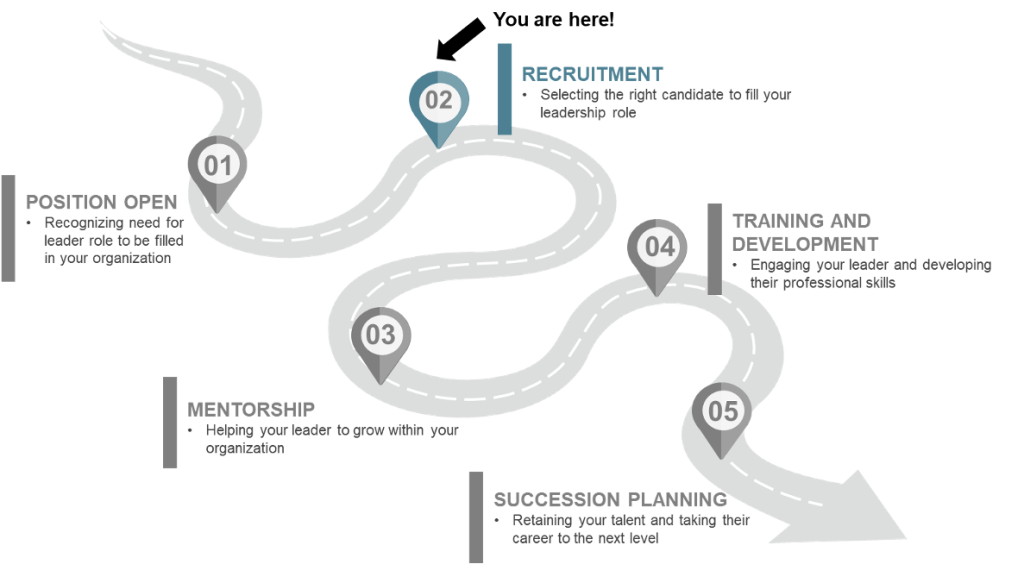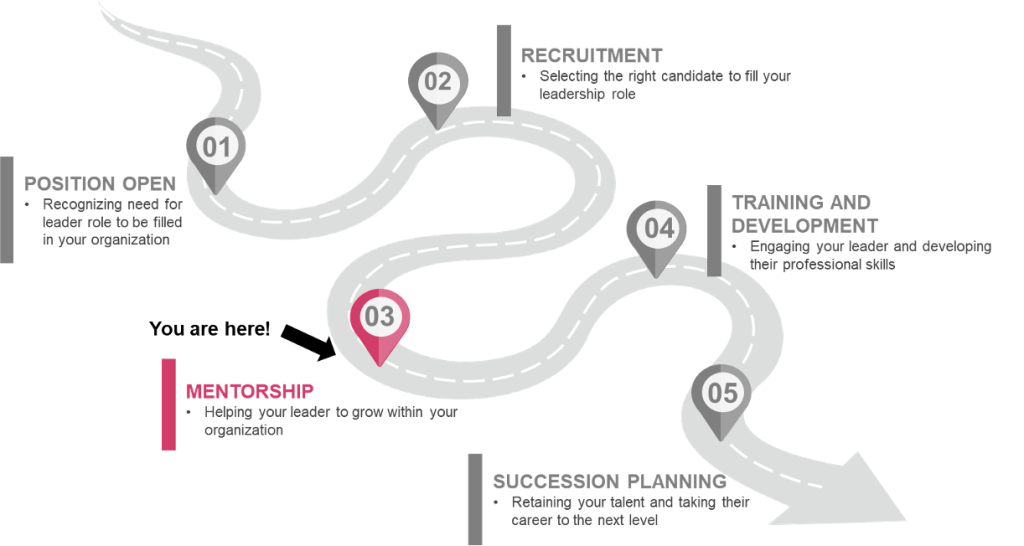Team Capacity
In This Section
Talent Processes
2.0 Pit Stop #2: Recruitment
Talent Processes
3.0 Pit Stop #3: Mentorship
Talent Processes
4.2 Growth and Development

2.0 Pit Stop #2: Recruitment
Welcome to Recruitment!
Now that you have determined the need to hire your leader, you need to recruit them and fill the role.
You should first start by asking yourself where you will source and recruit your talent from.
Based on this, you can implement the right mechanisms to ensure that all individuals are set up for success within your recruitment process.

2.1 Reflection Moment: How Will I Recruit to Fill This Role?
You can and should first turn inwards if you have an internal pool of candidates that meet the qualifications required. If not, you will need to source the candidate through external channels.

2.2 Internally Source Candidates: Questions to Ask Yourself to Select the Right Individual
1. What qualifies an internal candidate to be a successful leader in this role?
2. Are the skills and criteria I am looking for achievable by all internal candidates?
3. What process am I engaging in to fill this role internally? Is this process equally available to everyone?
- Appointment: Are all qualified candidates being considered before a leader is appointed?
- Nomination: Am I ensuring that all leaders who nominate a candidate have equal say?
- Selection: Am I considering all qualified candidates instead of just relying on those who apply?
4. Am I ensuring that the leader will bring in diverse perspectives currently not present on my leadership team?
5. Am I ensuring to use a uniform and consistent interview guide that assesses all candidates equally?
2.3.a Externally Source Candidates: Job Descriptions and Employment Postings
The first point of contact for a prospective candidate with an organization is through the Job Description and Employment Posting. This sets the tone and establishes your brand perception as an organization.
leading practices:
- Develop a page on your organization website and/or career portal dedicated to equity, diversity and inclusion and your commitments
- Dedicate an individual of your team to establish relationships with priority-group-based organizations to build a long-term pipeline of candidates
- Go beyond job postings and attend / contribute to events from community-based organizations
- Work cohesively with the marketing and public relations individual(s) of your organization to ensure your organization’s external brand image communicates your values on diversity
Specific actions to follow:
- Simplify language on job postings so it is clear and easy to understand
- Remove gender-coded words from job descriptions and postings
- Align the desired candidate qualifications and experiences to only those necessary to complete the role’s tasks. Consider the value of metrics that may create a barrier for specific priority groups, such as years of work experience or formal education
- Promote accessibility by posting to various channels. Ensure that the employment posting site is easy to navigate and simple to understand
- Conduct outreach to priority-group-based talent organizations and job boards to promote your organization’s opportunities
- Establish partnerships with organizations that work to advance candidates for priority groups
2.3.b Externally Source Candidates: Applicant Screening
Applicant Screening is a critical step through which candidates enter or are unable to enter the recruitment pipeline and subsequent next steps.
leading practices:
- Implement resume screening tools that remove personal identifiers within each application, to prevent bias from hiring manager(s)
Considerations for Intermediate / Advanced Organizations
Priority Group
Specific actions to follow:
- Remove personal identifiers from candidate applications that are not required or related to the role
- Develop criteria to ensure consistent screening across all recruiters per role
- Assess applications for skills stated in the job description, and focus on the “must-have’s”
2.3.c Externally Source Candidates: Candidate Interviewing
The interviewing process is what determines which candidates receive an employment opportunity in your organization, and can be heavily influenced by biases.
leading practices:
- Ensure that hiring panels consist of diverse interviewers of varying intersectional backgrounds, so that candidates can see themselves reflected in the organization
- Encourage post-interview debrief conversations amongst all interviewers to discuss each candidate with uniform criteria and ensure each candidate is assessed equally
- Provide regular unconscious bias training, guides to identifying personal bias within the recruitment process, and progress tracking to interviewers as part of a comprehensive approach to bias reduction
Specific actions to follow:
- Develop interview questions that are objective, relevant, and focus on core competencies required for the role
- Adopt a standardized interview process for each role, with a standard duration, set of questions, and objective criteria to identify a successful candidate
- Ensure that interview questions are focused on the role and would not put certain candidates at a disadvantage due to intersectional factors
- Ensure all interviews are conducted at minimum in pairs of interviewers, in order to prevent personal bias from one interviewer in impacting the final decision
2.3.d Externally Source Candidates: Candidate Experience
Whether a candidate receives an offer or not, the candidate experience during recruitment is critical to ensuring the candidate feels comfortable and has a lasting positive impression of your organization.
leading practices:
- Provide candidates with verbal and personal feedback if they are not selected for a role, to support their development and recruitment journey
Priority Group
This tip sheet from the Rick Hansen Foundation explains how to make your workspace accessible and getting your organization certified.
Specific actions to follow:
- Understand that all candidates hold unique needs that may not be easily or comfortably articulated. As an organization, adopt a proactive mindset to anticipate candidate needs and remove pressure from a candidate to disclose
- Provide candidates with the option of requesting accommodations if required
- Share resources, such as an Interview Success Guide, with candidates to provide clarity on the interview process and how to best prepare
Priority Group
Priority Group
Key Action
2.3.e Externally Source Candidates: Hiring Manager Enablement
It is important to ensure that your hiring manager is educated and aware on their role to mitigating bias during the recruitment process.
leading practices:
- Engage all hiring managers in bias training, as well as anti-racism and anti-discrimination training, on a regular basis
- Involve senior leadership by dedicating a Recruitment Champion, who receives updates from hiring managers on a minimum quarterly basis and is able to escalate any concerns from the group and provide resources
This article from Catalyst Canada provides guidance on how to hire women of colour
This training offered by Tidal Equality discusses bias and making equitable decisions
Specific actions to follow:
- Implement mechanisms to receive feedback from candidates to ensure continuous improvement of your recruitment process
- Ensure hiring managers meet internally on a regular basis to review and discuss processes with each other and address questions
- Create an interview guide for each role, so that all hiring managers are able to assess for each role equally and feel well-equipped to succeed
2.3.f Externally Source Candidates: Compensation and Total Rewards
When recruiting and providing an offer to a candidate, your organization must play a role in pay equity and reducing pay discrepancies.
leading practices:
- Explicitly state salary expectations or ranges for a leadership role within job description and/or during interview to avoid discrepancies in candidate expectations and negotiations
- Analyze existing pay across demographics within workforce to determine any discrepancies exist
Visit the Canadian Human Rights Commission website for more information on Federal pay equity practices and tools.
Visit the Pay Equity Council of Ontario website for more information and tools on provincial legislation.
Specific actions to follow:
- Ensure pay equity practices are up to date and implement regular reviewing period on a minimum annual basis
- Implement formal reward/recognition system that enables employees to recognize each other for their hard work through monetary and non-monetary means
- Implement a regular performance evaluation period, during which salary decisions are made
Considerations for Intermediate / Advanced Organizations
Recruitment: Regional and Industry Considerations
Industry: Banking and Financial Services
Research from Bloomberg in 2020 indicates that Canada’s banking industry falls behind Canadian national progress with regards to EDI. At most Canadian banks, over 33% of staff identify as non-white, yet only 10% of senior executive roles and 8% of non-executive board positions are held by Racialized, Black and/or People of Colour individuals.
Recruit intentionally and with EDI in mind. Historically, Canadian banks and financial institutions have recruited from the same pools of talent, hindering the advancement of priority group talent.
Consider the following:
- At the campus recruitment levels, student bodies within target schools are often not as diverse and pose financial barriers for diverse talent to enter. Seek partnerships with historically diverse educational institutions rather than focusing specifically on traditional target schools
- Facilitate employment opportunities focused on specific priority groups, to cater to their needs. Ensure that recruiters and interviewers leading the change identify with these priority groups
Region: Northern Canada
Organizations operating in Northern Canada often find it difficult to attract and recruit talent from priority groups, as the majority of talent tend to live in metropolitan, urban areas.
Consider the following:
- State opportunities for flexible working arrangements in job descriptions where possible, to expand the talent pool outside of the closest physical community. Flexible work can include remote working or hybrid working
- Increase partnerships with community-based employment organizations, which offer job boards, resources and/or candidate matching with priority group talent
View the Government of Northwest Territories Indigenous Recruitment and Retention Framework
View the Government of Northwest Territories Indigenous Recruitment and Retention Action Plan
Industry: Food Services
According to Restaurants Canada, EDI considerations bring economic, operational, and morale benefits to the business. The food services sector is a leader in providing opportunities to priority group candidates.
Consider the following:
- Remove areas of the job application that require a candidate to disclose the country in which they obtained their experience
- Use competency-based measures to assess or showcase a candidate’s skills (job-related testing, behavioural interview questions, scenarios, etc.)
- Recognize the value of on-the-job training
Scenario: Checkpoint 1


3.0 Pit Stop #3: Mentorship
Welcome to Mentorship!
Now that you have hired your leader, your next step is to help them grow within your organization.
Mentorship fosters a sense of belonging and ensures your leaders are able to learn from others on how to be successful within their role.
It is critical that mentorship is offered equally to everyone, and that the mentor opportunities cater to the unique identities of all leaders.

3.1 Mentorship: Formal Mentorship Opportunities
Formal mentorship opportunities are organization-developed programs that provide employees with the tools to enhance their leadership capabilities.
leading practices:
- Focus specific mentorship programs / events on allyship to encourage leaders to support co-workers who identify as 2SLGBTQ+ and/or gender and sexually diverse individuals
- Facilitate mentor training on how to become an impactful mentor and champion for leaders
- Encourage senior leaders and board members to open space in their schedules to allow for mentorship opportunities for the next generation of leaders
Specific actions to follow:
- Establish formal mentorship programs within your organization to support high-potential and board-ready talent in receiving active feedback and coaching to achieve senior leadership positions
- Allow mentorship programs to be sponsored by senior leaders to ensure that junior leaders are receiving visibility and benefit from expansion of their network
- Advise mentors to encourage mentees of priority groups and empower them to apply for leadership roles
- Provide equal mentorship opportunities to all leaders to remove influence of informal mentorship mechanisms
- Mentorship program activities should be inclusionary in nature. All mentees should receive an invitation and options to ensure the activity is not “traditionally exclusionary” (e.g. team-building events rather than golfing or hockey games, dinner at a restaurant rather than drinks after work)
Case Study
Considerations for Intermediate / Advanced Organizations
This article from RevolutionHer discusses the importance of mentorship.
Mentorship: Regional and Industry Considerations
Industry: Technology
The 2020 People of Colour in Tech report demonstrated that less than 5% of the workforce for large technology companies are composed of Black, Latinx and “Aboriginal” and/or Indigenous tech professionals. Employees of Colour find it difficult to access mentors, and Black employees reported it 62% more difficult to find a mentor than white respondents.
Priority group employees in the technology sector often do not see many leaders who look like them, and struggle to progress within the organization due to a lack of exposure.
Consider the following:
- Design mentorship programs keeping in mind career progression, to enable priority group employees to achieve leadership positions
- Host priority-group specific technology mentorship events, such as Black Professionals in Tech
- Partner with community-based organizations to provide mentorship to young professionals looking to enter the technology industry
Region: Atlantic Canada
According to a 2022 report from the Atlantic Provinces Economic Council, women are well represented in employment in Atlantic Canada, consisting of approximately 50% of the workforce. Racialized, Black and/or People of Colour however only account for about 1 in 20 workers. The report also indicated that Black employees specifically are less likely to be promoted to manager and leader roles.
Consider the following:
- Provide mentorship opportunities specific to diverse talent and leaders new to Atlantic Canada to help them expand their local network, and reduce social isolation that often arises from not being a local
- Ensure mentors can provide education and learning for those learning French, if required by the role
- Provide training on intersectionality to mentors, so they are able to support diverse talent

4.2 Growth & Development
4.2 Training and Development: Growth and Development
In addition to training, there are several other ways your organization can support the growth and development of your leaders.
leading practices:
- Host cultural competency workshops for leaders, in partnership with priority-group-based organizations
- Assign internal coaches to leaders who can work with them to action their growth and development goals
Specific actions to follow:
- Establish professional development programs to help leaders achieve their professional goals
- Promote a culture of continuous learning and development through internal communications and messaging from senior leadership
Priority Group
Key Action
Case Study
Considerations for Intermediate / Advanced Organizations
This Cultural Competency Training is hosted by the New Brunswick Multicultural Council.
Training and Development: Regional and Industry Considerations
Industry: Fisheries and Oceans
The ocean sector is lagging behind in attracting a diverse labour force as opportunities in this industry are not highly visible due to their niche, technical training and hiring processes.
To improve inclusion of women and/or non-binary individuals within the sector, consider the following:
- Improve education and awareness that a career in the ocean sector is viable and accessible; partner with women and/or non-binary individuals, allies, and employers
- Sponsor women and/or non-binary individuals to pursue leadership roles within the organizations and encourage them to offer diverse perspectives on company management and talent attraction
- To pursue work as newcomers without prior connections to this field, women and/or non-binary individuals would benefit from additional resources, financial aid (gender issues can complicate pursuit of first-time loans), assets (support to purchase a boat/equipment, obtain a license), access to well-advertised education/financial opportunities, networking and mentorship
Industry: Healthcare
According to a report from Osler, in 2021, only 15% of Executive Officers and 17% of Board Members identified as a woman in the Life Sciences Industry, ranking as the smallest percentage from 13 industries.
Diversity in healthcare is important to ensure equitable healthcare outcomes for staff and patients as well.
Consider the following:
- Provide training to staff to understand the importance of accommodation to meet priority group healthcare needs
- Dedicate leaders to oversee training and partnerships for priority group healthcare education
This Inclusion Playbook from the 519 discusses how to support 2SLGBTQ+ and/or gender and sexually diverse individuals and learn about leading practices.
Case Study
Scenario: Checkpoint 2

Back to All Tiles
